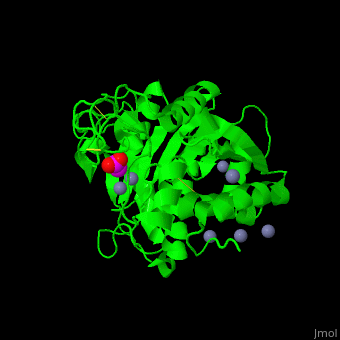Carboxypeptidase
From Proteopedia
FunctionCarboxypeptidase (CP) cleaves the amino acid at the C terminal of a polypeptide chain. 2-guanidinoethylmercaptosuccinic acid (GEMSA) is a potent inhibitor of CP.
See also Protease. RelevanceGlutamate carboxypeptidase II is a potential target for imaging and therapy of prostate carcinoma and attenuation of neurotoxicity. Structural highlightsThe active site Zn+2 is located at the bottom of a pocket open to the surface of the enzyme.[4] 3D Structures of CarboxypeptidaseCarboxypeptidase 3D structures
|
| |||||||||||
References
- ↑ Fernandez D, Boix E, Pallares I, Aviles FX, Vendrell J. Structural and Functional Analysis of the Complex between Citrate and the Zinc Peptidase Carboxypeptidase A. Enzyme Res. 2011;2011:128676. doi: 10.4061/2011/128676. Epub 2011 Jul 25. PMID:21804935 doi:10.4061/2011/128676
- ↑ Adler M, Bryant J, Buckman B, Islam I, Larsen B, Finster S, Kent L, May K, Mohan R, Yuan S, Whitlow M. Crystal structures of potent thiol-based inhibitors bound to carboxypeptidase B. Biochemistry. 2005 Jul 5;44(26):9339-47. PMID:15982000 doi:http://dx.doi.org/10.1021/bi0501941
- ↑ Arce CA, Barra HS. Association of tubulinyl-tyrosine carboxypeptidase with microtubules. FEBS Lett. 1983 Jun 27;157(1):75-8. doi: 10.1016/0014-5793(83)81119-3. PMID:6862022 doi:http://dx.doi.org/10.1016/0014-5793(83)81119-3
- ↑ Yoshimoto N, Itoh T, Inaba Y, Ishii H, Yamamoto K. Structural Basis for Inhibition of Carboxypeptidase B by Selenium-Containing Inhibitor: Selenium Coordinates to Zinc in Enzyme. J Med Chem. 2013 Sep 24. PMID:24010887 doi:10.1021/jm400816v
Proteopedia Page Contributors and Editors (what is this?)
Michal Harel, Alexander Berchansky, Joel L. Sussman, Jaime Prilusky

